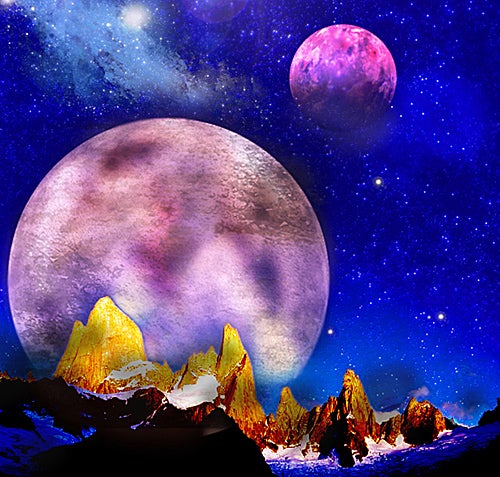Careening planets wreaking havoc may seem like the stuff of science fiction, but according to a study by researchers at the University of California, Berkeley, and Northwestern University, it really can happen.
A puzzling aspect of many extrasolar planets is the unusually out-of-round orbits they follow around their stars. Planets in our solar system follow nearly circular orbits, as expected if they formed by accretion of material in the same disk of debris that gave birth to the Sun.
In the new study, scientists examined 13 years of observations of three planets orbiting the sunlike star Upsilon Andromedae (Ups And) 44 light-years away. “This is probably one of the two or three extrasolar systems that have the best observations and tightest constraints, and it tells a unique story,” says Eric Ford, the Berkeley astronomer who led the study.
Gravitational interactions with a fourth planet, he says, warped the orbit of what astronomers now see as the outermost world, designated Ups And d. This planet weighs in at 10 Jupiter masses and now orbits 3.75 times farther from its star than Earth does the Sun.
These same interactions shot the trouble-making fourth planet entirely out of the system, but that wasn’t the end of the story. Ups And d’s perturbed orbit excited periodic changes in the orbit of Ups And c, the next planet in. Ups And c is a 1.9 Jupiter-mass planet that circles the star at about 80 percent of Earth’s distance from our Sun. The team reported its results in today’s issue of the journal Nature.
“While the planets in our solar system remain stable for billions of years, that wasn’t the case for the planets orbiting Upsilon Andromedae,” Ford says. “While those planets might have formed similarly to Jupiter and Saturn, their current orbits were sculpted by a late phase of chaotic and violent interactions.”
Astronomers disarmingly refer to this caroming-world scenario as “planet-planet scattering,” which team member Frederic Rasio of Northwestern University describes as “a sort of slingshot effect due to the sudden gravitational pull between two planets when they come very near each other.”
“We believe planet-planet scattering occurred frequently in extrasolar planetary systems,” Rasio says. “So, while planetary systems around other stars may be common, the kinds of systems that could support life, which, like our solar system, presumably must remain stable over very long time scales, may not be so common.”
The planetary system around Upsilon Andromedae is one of the most studied so far. The inner planet, Ups And b, is a “hot Jupiter” so close to the star that it takes only 4.6 days to complete an orbit. It was discovered in 1996 by Berkeley’s Geoff Marcy and his planet-hunting team. When the two outer planets were discovered in 1999, Ups And became the first known multiplanet extrasolar system around a sunlike star.
Upsilon Andromedae’s unusual nature prompted unusual attention. Marcy and his team have made nearly 500 observations. Wobbles in the star’s motion induced by the orbiting planets allow astronomers to infer the motions of the planets. These observations are so precise, says Ford, “[W]e can watch and predict what will happen for tens of thousands of years in the future.”
Astronomers didn’t have enough observational data to distinguish between two different models accounting for the Ups And system. Renu Malhotra at the University of Arizona first suggested planet-planet scattering might have excited the orbital eccentricities in Upsilon Andromedae’s planetary system. But an alternative explanation claimed interactions among the planets and the disk in which they formed also could have produced elongated orbits.
“The key distinguishing feature between those theories was that interactions with an outer disk would cause the orbits to change very slowly, and a strong interaction with a passing planet would cause the orbits to change very quickly,” explains Ford.
The orbital cycle of Ups And c actually gives the planet a circular orbit every 6,700 years. “That property … is quite remarkable and generally doesn’t happen.”
“This is what makes the system so peculiar,” Rasio says. “Ordinarily, the gravitational coupling between two elliptic orbits would never make one go back to a nearly perfect circle. A circle is very special.”
The fact that Ups And c’s orbit regularly becomes circular suggests that it began that way. And the 6,700-year cycle of orbital change hints that whatever altered the system did so very quickly.
Initially, the team ran computer simulations in order to determine if Ups And’s outermost planets orbited in the same plane, something made more challenging by the middle planet’s periodic circular orbits. The odd behavior was present in all of the simulations. Eventually, the astronomers realized it was the hallmark of a system that had undergone planet-planet scattering.
“Once you realize that most of the known extrasolar planets have highly eccentric orbits, you begin to wonder if there might be something special about our solar system,” says Ford. “Could violent planet-planet scattering be so common that few planetary systems remain calm and habitable?”
Stay tuned for the answer.










